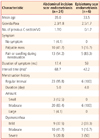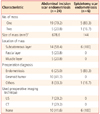Abstract
Objective
To investigate the characteristics and to define the most effective diagnosis and treatment option for the scar endometriosis resulting from abdominal incision or episiotomy.
Methods
Medical records of thirty women with scar endometriosis who underwent mass excision between 1996 and 2008 in our hospital were reviewed retrospectively. Data on the age, parity, surgical history, symptom, menstrual history, characteristics of the mass, preoperative diagnosis, treatment method and recurrence were analyzed.
Results
Scar endometriosis were developed after Cesarean section in 24 patients and episiotomy in 6 patients. Nearly all patients presented with a palpable mass with or without cyclic pain and mean duration of symptom was 23.8 months. Preoperative imaging study was performed in 14 patients, however there was no one whose preoperative imaging result was endometriosis. All scar endometriosis was completely excised with surrounding tissue. Gonadotrophin releasing hormone (GnRH) agonist was administered in 13 patients pre- or postoperatively. Recurrence of scar endometriosis after wide mass excision was noted in 4 patients (13.3%) who did not receive GnRH agonist therapy pre- or postoperatively.
Conclusion
This study supports that scar endometriosis is a result of the transplantation of endometrial tissue during procedures. The contribution of the imaging studies seems to be limited, so surgeon could perform mass excision for diagnosis and treatment with clinical history and physical exam without performing imaging study especially in for small scar endometriosis. Surgical excision accompanied by pre-, or postoperative GnRH agonist therapy may be helpful option for the prevention of recurrence however, we could not find any statistical significance in the effectiveness of GnRH agonist treatment.
Figures and Tables
References
1. Firilas A, Soi A, Max M. Abdominal incision endometriomas. Am Surg. 1994. 60:259–261.
2. Bumpers HL, Butler KL, Best IM. Endometrioma of the abdominal wall. Am J Obstet Gynecol. 2002. 187:1709–1710.
3. Wakefield SE, Hellen EA. Endometrioma of the trocar site after laparoscopy. Eur J Surg. 1996. 162:523–524.
4. Gaunt A, Heard G, McKain ES, Stephenson BM. Caesarean scar endometrioma. Lancet. 2004. 364:368.
5. Roncoroni L, Costi R, Violi V, Nunziata R. Endometriosis on laparotomy scar. A three-case report. Arch Gynecol Obstet. 2001. 265:165–167.
6. Chatterjee SK. Scar endometriosis: a clinicopathologic study of 17 cases. Obstet Gynecol. 1980. 56:81–84.
7. Gordon PH, Schottler JL, Balcos EG, Goldberg SM. Perianal endometrioma: report of five cases. Dis Colon Rectum. 1976. 19:260–265.
8. Kaunitz A, Di Sant'Agnese PA. Needle tract endometriosis: an unusual complication of amniocentesis. Obstet Gynecol. 1979. 54:753–755.
9. Brenner C, Wohlgemuth S. Scar endometriosis. Surg Gynecol Obstet. 1990. 170:538–540.
10. Hasson HM. Incidence of endometriosis in diagnostic laparoscopy. J Reprod Med. 1976. 16:135–138.
11. Lee SE, Jeong JE, Joo JK, Lee KS. Clinicopathologic review of extrapelvic endometriosis. Korean J Obstet Gynecol. 2012. 55:83–88.
12. Koger KE, Shatney CH, Hodge K, McClenathan JH. Surgical scar endometrioma. Surg Gynecol Obstet. 1993. 177:243–246.
13. Park TS, Her IS, Lee HW, Jo YY, Park JB, Kang HJ. Two cases of endometriosis at the subcutaneous tissue of the abdominal scar after cesarean section. Korean J Obstet Gynecol. 2004. 47:752–758.
14. Bektaş H, Bilsel Y, Sari YS, Ersöz F, Koç O, Deniz M, et al. Abdominal wall endometrioma; a 10-year experience and brief review of the literature. J Surg Res. 2010. 164:e77–e81.
15. de Oliveira MA, de Leon AC, Freire EC, de Oliveira HC. Risk factors for abdominal scar endometriosis after obstetric hysterotomies: a case-control study. Acta Obstet Gynecol Scand. 2007. 86:73–80.
16. Park JY, Hong SR, Lee TY, Kong DS, Park YJ, Suh YU, et al. Clinical review of endometriosis in the abdominal scar following cesarean section. Korean J Obstet Gynecol. 1999. 42:729–734.
17. Wolf Y, Haddad R, Werbin N, Skornick Y, Kaplan O. Endometriosis in abdominal scars: a diagnostic pitfall. Am Surg. 1996. 62:1042–1044.
18. Mitchell GW. Schenken RS, editor. Extrapelvic endometriosis. Endometriosis: contemporary concepts in clinical management. 1989. Philadelphia: JB Lippincott;307–328.
19. Pittaway DE, Douglas JW. Serum CA-125 in women with endometriosis and chronic pelvic pain. Fertil Steril. 1989. 51:68–70.
20. Picod G, Boulanger L, Bounoua F, Leduc F, Duval G. Abdominal wall endometriosis after caesarean section: report of fifteen cases. Gynecol Obstet Fertil. 2006. 34:8–13.
21. Seydel AS, Sickel JZ, Warner ED, Sax HC. Extrapelvic endometriosis: diagnosis and treatment. Am J Surg. 1996. 171:239.
22. Blanco RG, Parithivel VS, Shah AK, Gumbs MA, Schein M, Gerst PH. Abdominal wall endometriomas. Am J Surg. 2003. 185:596–598.
23. Hong HJ, Chung BS, Son EJ, Yun BI, Kim SJ, Kim SY, et al. Abdominal wall endometriosis after cesarean section: a report of two cases. Korean J Obstet Gynecol. 2005. 48:228–233.
24. Lee IH, Baek JK, Woo HJ, Hong JS, Chun YK, Hong JS. A case of perineal endometriosis at the site of episiotomy scar. Korean J Obstet Gynecol. 2004. 47:1232–1235.
25. Kang KS, Oh JY, Park SY, Moon JB, Hong SK, Lee YH. Two cases of endometriosis at the site of episiotomy scar and abdominal scar following cesarean section. Korean J Obstet Gynecol. 2004. 47:1611–1614.
26. Kim JH, Han CD, Huh CK, Cho CH, Koh SB. Two cases of myxoid change in decidualized cutaneous endometriosis in the abdominal scar following cesarean section and immunohistochemical study. Korean J Obstet Gynecol. 2002. 45:153–157.




 PDF
PDF ePub
ePub Citation
Citation Print
Print





 XML Download
XML Download